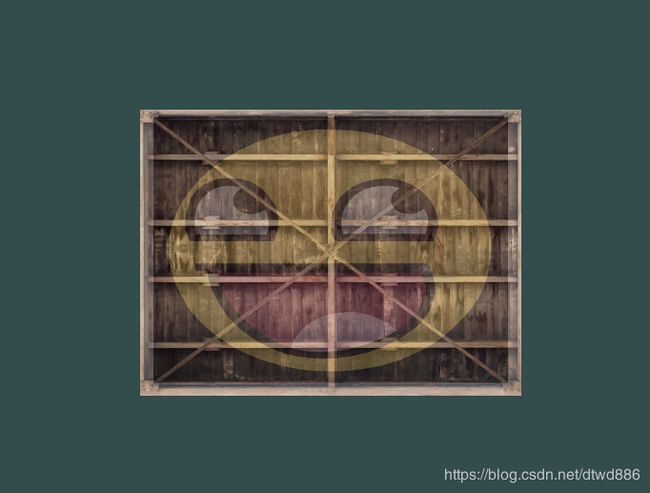OpenGL入门之纹理
窗口代码:
/*OpenGL之窗口初始化*/
#include
#include
#include
#include
#include
#include "Shader.h"
#define STB_IMAGE_IMPLEMENTATION
#include "stb_image.h"
void framebuffer_size_callback(GLFWwindow* windows, int width, int height);
void processInput(GLFWwindow *windows);
unsigned int shaderProgram;
std::string vertexCode;
std::string fragmentCode;
std::ifstream vShaderFile; //文件输入流
std::ifstream fShaderFile;
int success; //定义一个整型变量来表示是否成功编译
char infoLog[512]; //存储错误消息的容器
unsigned int VBO; //顶点缓冲对象
unsigned int VAO; //顶点数组对象
unsigned int EBO;
unsigned int vertexShader; //通过ID引用
unsigned int fragmentShader;
unsigned int texture1; //创建纹理的ID
unsigned int texture2;
int main()
{
glfwInit(); //初始化GLFW
glfwWindowHint(GLFW_CONTEXT_VERSION_MAJOR, 3); //将主版本号和此版本号都设为3
glfwWindowHint(GLFW_CONTEXT_VERSION_MINOR, 3);
glfwWindowHint(GLFW_OPENGL_PROFILE, GLFW_OPENGL_CORE_PROFILE); //明确告诉GLFW使用的是核心模式
GLFWwindow* window = glfwCreateWindow(800, 600, "LearnOpenGL", NULL, NULL); //创建窗口对象
if (window == NULL)
{
std::cout << "Failed to create GLFW window" << std::endl;
glfwTerminate();
return -1;
}
glfwMakeContextCurrent(window); //将窗口的上下文设置为当前线程的主上下文
glfwSetFramebufferSizeCallback(window, framebuffer_size_callback); //注册窗口的大小改变时,视口也应该被调整的函数
if (!gladLoadGLLoader((GLADloadproc)glfwGetProcAddress)) // 调用任何OpenGL的函数之前需要初始化GLAD:给GLAD传入了用来加载系统相关的OpenGL函数指针地址的函数
{
std::cout << "Failed to initialize GLAD" << std::endl;
return -1;
}
glViewport(0, 0, 800, 600); //设置渲染窗口的尺寸大小,即视口,这样OpenGL才知道怎样根据窗口大小显示数据和坐标,前两个参数控制窗口左下角的位置。第三个和第四个参数控制渲染窗口的宽度和高度(像素)
Shader ourShader("vshader.vs", "fshader.fs");
int nrAttributes;
glGetIntegerv(GL_MAX_VERTEX_ATTRIBS, &nrAttributes);
std::cout << "Maximun nr of vertex attributes supported:" << nrAttributes << std:: endl;
float vertices[] = {
//位置 //颜色
0.5f,0.5f,0.0f,1.0f,0.0f,0.0f,1.0f,1.0f,
0.5f,-0.5f,0.0f,0.0f,1.0f,0.0f,1.0f,0.0f,
-0.5f,-0.5f,0.0f,0.0f,0.0f,1.0f,0.0f,0.0f,
-0.5f,0.5f,0.0f,1.0f,1.0f,0.0f,0.0f,1.0f
};
unsigned int indices[] = {//注意索引从0开始
0,1,3,//第一个三角形
1,2,3 //第二个三角形
};
glGenBuffers(1, &VBO); //创建顶点缓冲对象
glGenVertexArrays(1, &VAO); //创建顶点数组对象
glGenBuffers(1, &EBO); //创建索引缓冲对象
//绑定VAO
glBindVertexArray(VAO);
//把顶点数组复制到缓冲中供OpenGL使用
glBindBuffer(GL_ARRAY_BUFFER, VBO); //绑定顶点缓冲对象
glBindBuffer(GL_ELEMENT_ARRAY_BUFFER, EBO); //绑定索引缓冲对象
glBufferData(GL_ARRAY_BUFFER, sizeof(vertices), vertices, GL_STATIC_DRAW);//复制顶点数组到一个顶点缓冲中,供OpenGL使用
glBufferData(GL_ELEMENT_ARRAY_BUFFER, sizeof(indices), indices, GL_STATIC_DRAW);//复制索引数组到一个索引缓冲中,供OpenGL使用
/*设置顶点属性指针,第一个参数指定要配置的顶点属性,第二个参数指定顶点属性的大小,第三个参数指定数据的类型,
第四个参数定义是否希望数据被标准化,第五个参数叫做步长,最后一个参数类型是void*(为偏移量)*/
glVertexAttribPointer(0, 3, GL_FLOAT, GL_FALSE, 8 * sizeof(float), (void*)0);
glVertexAttribPointer(1, 3, GL_FLOAT, GL_FALSE, 8 * sizeof(float), (void *)(3*sizeof(float)));
glVertexAttribPointer(2, 2, GL_FLOAT, GL_FALSE, 8 * sizeof(float), (void *)(6 * sizeof(float)));
glEnableVertexAttribArray(0); //以顶点属性位置值作为参数,启用顶点属性
glEnableVertexAttribArray(1);
glEnableVertexAttribArray(2);
glBindVertexArray(0);
glBindBuffer(GL_ARRAY_BUFFER, 0);
/*
/当目标是GL_ELEMENT_ARRAY_BUFFER的时候,VAO会储存glBindBuffer的函数调用。
这也意味着它也会储存解绑调用,所以确保你没有在解绑VAO之前解绑索引数组缓冲,否则它就没有这个EBO配置
*/
glBindBuffer(GL_ELEMENT_ARRAY_BUFFER, 0);
/*生成纹理的过程*/
glGenTextures(1, &texture1); // 函数首先需要输入生成纹理的数量,然后把它们存储在第二个参数的unsigned int数组中
glGenTextures(1, &texture2); // 函数首先需要输入生成纹理的数量,然后把它们存储在第二个参数的unsigned int数组中
//加载并生成纹理
int width1, height1, nrChannels1;
int width2, height2, nrChannels2;
stbi_set_flip_vertically_on_load(true);//指示stb_image.h在y轴上翻转加载纹理
unsigned char *data1 = stbi_load("container.jpg", &width1, &height1, &nrChannels1,0);
unsigned char *data2 = stbi_load("awesomeface.png", &width2, &height2, &nrChannels2, 0);
if (data1)
{
glBindTexture(GL_TEXTURE_2D, texture1); //像其他对象一样,需要绑定它,之后任何的纹理指令都可以配置当前绑定的纹理
//为当前绑定的纹理对象设置环绕、过滤方式
glTexParameteri(GL_TEXTURE_2D, GL_TEXTURE_WRAP_S, GL_REPEAT);
glTexParameteri(GL_TEXTURE_2D, GL_TEXTURE_WRAP_T, GL_REPEAT);
glTexParameteri(GL_TEXTURE_2D, GL_TEXTURE_MIN_FILTER, GL_LINEAR);
glTexParameteri(GL_TEXTURE_2D, GL_TEXTURE_MAG_FILTER, GL_LINEAR);
glTexImage2D(GL_TEXTURE_2D, 0, GL_RGB, width1, height1, 0, GL_RGB, GL_UNSIGNED_BYTE, data1);//第一个参数指定纹理目标,第二个参数为纹理指定多级渐远纹理级别,0为基本级别,第三个参数代表希望把纹理存储为何种格式,第七、八个参数定义了源图的格式和数据类型,最后一个参数是真正的图像数据
glGenerateMipmap(GL_TEXTURE_2D); //为当前绑定的纹理自动生成所有需要的多级渐远纹理
}
else
{
std::cout << "Failed to load texture" << std::endl;
}
if (data2)
{
glBindTexture(GL_TEXTURE_2D, texture2); //像其他对象一样,需要绑定它,之后任何的纹理指令都可以配置当前绑定的纹理
//为当前绑定的纹理对象设置环绕、过滤方式
glTexParameteri(GL_TEXTURE_2D, GL_TEXTURE_WRAP_S, GL_REPEAT);
glTexParameteri(GL_TEXTURE_2D, GL_TEXTURE_WRAP_T, GL_REPEAT);
glTexParameteri(GL_TEXTURE_2D, GL_TEXTURE_MIN_FILTER, GL_LINEAR);
glTexParameteri(GL_TEXTURE_2D, GL_TEXTURE_MAG_FILTER, GL_LINEAR);
glTexImage2D(GL_TEXTURE_2D, 0, GL_RGBA, width2, height2, 0, GL_RGBA, GL_UNSIGNED_BYTE, data2);//第一个参数指定纹理目标,第二个参数为纹理指定多级渐远纹理级别,0为基本级别,第三个参数代表希望把纹理存储为何种格式,第七、八个参数定义了源图的格式和数据类型,最后一个参数是真正的图像数据
glGenerateMipmap(GL_TEXTURE_2D); //为当前绑定的纹理自动生成所有需要的多级渐远纹理
}
else
{
std::cout << "Failed to load texture" << std::endl;
}
stbi_image_free(data1);
stbi_image_free(data2);
ourShader.use();
ourShader.setInt("texture1", 0);//通过使用着色器类告诉OpenGL每个着色器采样器属于哪个纹理单元
ourShader.setInt("texture2", 1);
//渲染循环,在主动关闭它之前不断绘制图像并能够接受用户输入
while (!glfwWindowShouldClose(window)) //在循环的开始前检查一次GLFW是否被要求退出,是的话该函数返回true,渲染循环便结束
{
/*float timeValue = glfwGetTime();
float greenValue = (sin(timeValue) / 2.0f) + 0.5f;
int vertexColorLocation = glGetUniformLocation(shader.ID, "ourColor");*/
processInput(window);
glClearColor(0.2f, 0.3f, 0.3f, 1.0f); //设置清空屏幕所用的自定义颜色,为状态设置函数
glClear(GL_COLOR_BUFFER_BIT); //通过调用glClear函数来清空屏幕的颜色缓冲,为状态使用函数
//绑定纹理到相应纹理单元(此处为0和1)
glActiveTexture(GL_TEXTURE0);
glBindTexture(GL_TEXTURE_2D, texture1);
glActiveTexture(GL_TEXTURE1);
glBindTexture(GL_TEXTURE_2D, texture2);
ourShader.use(); //当渲染一个物体时要使用着色器程序
glBindVertexArray(VAO); //绑定VAO
//glUniform4f(vertexColorLocation, 0.0f, greenValue, 0.0f, 1.0f); //设置uniform属性值
//glPolygonMode(GL_FRONT_AND_BACK, GL_LINE);//使用线框模式绘制三角形,默认为glPolygonMode(GL_FRONT_AND_BACK, GL_FILL)
glDrawElements(GL_TRIANGLES, 6, GL_UNSIGNED_INT,0); //绘制想要的物体
glfwSwapBuffers(window); //函数会交换颜色缓冲(是一个储存着GLFW窗口每一个像素颜色的值得大缓冲)
glfwPollEvents(); //函数检查有没有触发什么事件(比如键盘输入,鼠标移动等)、更新窗口状态
}
//删除所有分配的资源
glDeleteVertexArrays(1, &VAO);
glDeleteBuffers(1, &VBO);
glDeleteBuffers(1, &EBO);
glfwTerminate(); //渲染循环结束后需要正确释放/删除之前的分配的所有资源
return 0;
}
void framebuffer_size_callback(GLFWwindow* window, int width, int height) //视口根据窗口大小调整的函数,两个整数表示窗口的新维度
{
glViewport(0, 0, width, height);
}
void processInput(GLFWwindow *window) //输入的控制
{
if (glfwGetKey(window, GLFW_KEY_ESCAPE) == GLFW_PRESS) // glfwGetKey函数需要一个窗口以及一个按键作为输入,函数将会返回这个按键是否正在被按下
glfwSetWindowShouldClose(window, true);
} 顶点着色器:
#version 330 core
layout(location=0)in vec3 aPos;
layout(location=1)in vec3 aColor;
layout(location=2)in vec2 aTexCoord;
out vec3 ourColor;
out vec2 TexCoord;
void main()
{
gl_Position=vec4(aPos.x,aPos.y,aPos.z,1.0);
ourColor=aColor; //将ourColor设置为从顶点数据那里得到的输入颜色
TexCoord=aTexCoord;
}
片段着色器:
#version 330 core
out vec4 FragColor;
in vec3 ourColor;
in vec2 TexCoord;
uniform sampler2D texture1; // 纹理1
uniform sampler2D texture2; // 纹理2
void main()
{
FragColor=mix(texture(texture1,TexCoord),texture(texture2,TexCoord),0.2);
}
container.jpg
awesomeface.png
效果图:
